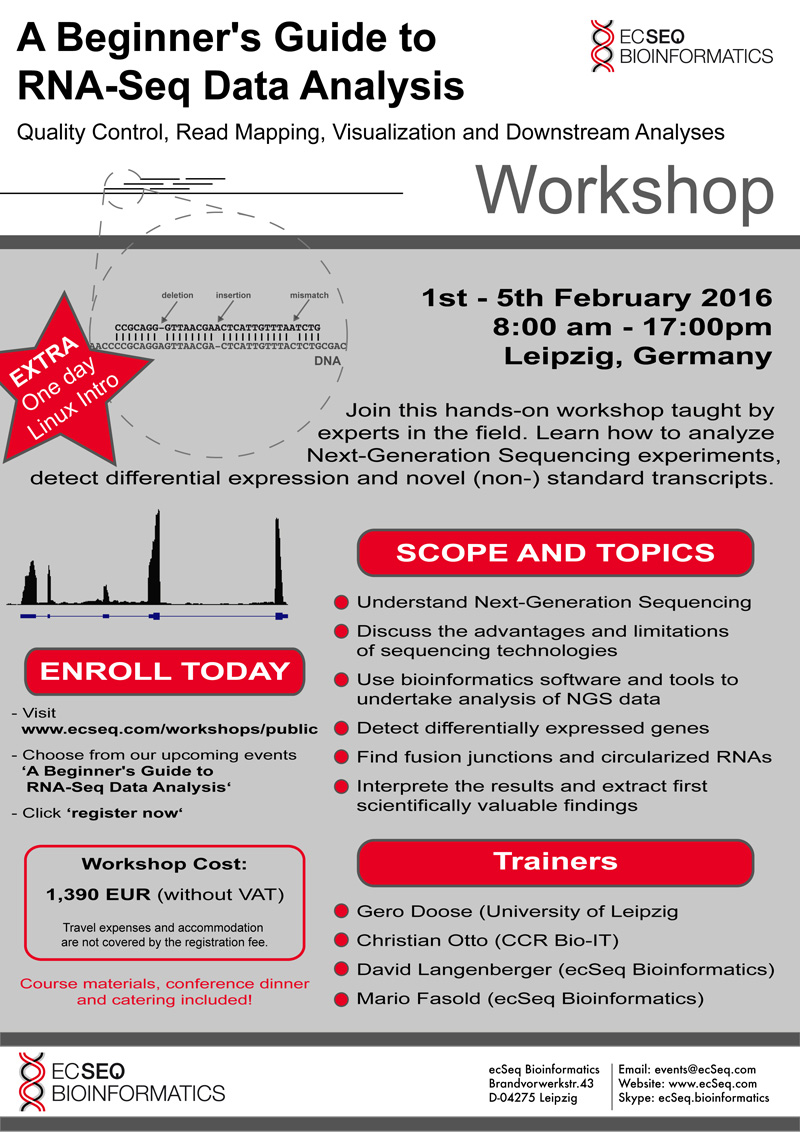A Beginner's Guide to RNA-Seq Data Analysis
Quality Control, Read Mapping, Visualization and Downstream Analyses
When?
1 - 5 February 2016
Where?
iad Pc-Pool, Rosa-Luxemburg-Straße 23, Leipzig, Germany
Link?
http://www.ecseq.com/workshops/rna-seq_2016-01
Scope and Topics
The purpose of this workshop is to get a deeper understanding in Next-Generation Sequencing (NGS) with a special focus on bioinformatics issues. Additionally, all workshop participants should be enabled to perform important tasks of NGS data analysis tasks themselves.
The first workshop module is an introduction to data analysis using Linux, assuring that all participants are able to follow the practical parts. The second module dicusses advantages and disadvantages of current sequencing technologies and their implications on data analysis. The most important NGS file formats (fastq, sam/bam, bigWig, etc.) are introduced and one proceeds with first hands-on analyses (QC, mapping, visualization). You will learn how to read and interprete QC plots, clip adapter sequences and/or trim bad quality read ends, get bioinformatics backgrounds about the read mapping and understand its problems (dynamic programming, alignment visualization, NGS mapping heuristics, etc.), perform your own mapping statistics and visualize your data in different ways (IGV, UCSC, etc.). The last module adresses a specific applications of NGS: RNA-seq data analysis and detection of differentially expressed genes.
Workshop Structure
This workshop has been redesigned and adapted to the needs of beginners in the field of NGS bioinformatics and comprises this three course modules:
Requirements
Target Audience
Included in the Course
Speakers
Key Dates
Opening Date of Registration: 1 Juli 2015
Closing Date of Registration: 15 January 2016
Workshop: 1 - 5 February 2016 (8 am - 5 pm)
Attendance
Location: iad Pc-Pool, Rosa-Luxemburg-Straße 23, Leipzig, Germany
Language: English
Available seats: 24 (first-come, first-served)
Registration fees:
registration fee: 1,390 EUR (without VAT)
Travel expenses and accommodation are not covered by the registration fee.
Contact
ecSeq Bioinformatics
Brandvorwerkstr.43
04275 Leipzig
Germany
Email: [email protected]
Here you can get more information or apply!
Quality Control, Read Mapping, Visualization and Downstream Analyses
When?
1 - 5 February 2016
Where?
iad Pc-Pool, Rosa-Luxemburg-Straße 23, Leipzig, Germany
Link?
http://www.ecseq.com/workshops/rna-seq_2016-01
Scope and Topics
The purpose of this workshop is to get a deeper understanding in Next-Generation Sequencing (NGS) with a special focus on bioinformatics issues. Additionally, all workshop participants should be enabled to perform important tasks of NGS data analysis tasks themselves.
The first workshop module is an introduction to data analysis using Linux, assuring that all participants are able to follow the practical parts. The second module dicusses advantages and disadvantages of current sequencing technologies and their implications on data analysis. The most important NGS file formats (fastq, sam/bam, bigWig, etc.) are introduced and one proceeds with first hands-on analyses (QC, mapping, visualization). You will learn how to read and interprete QC plots, clip adapter sequences and/or trim bad quality read ends, get bioinformatics backgrounds about the read mapping and understand its problems (dynamic programming, alignment visualization, NGS mapping heuristics, etc.), perform your own mapping statistics and visualize your data in different ways (IGV, UCSC, etc.). The last module adresses a specific applications of NGS: RNA-seq data analysis and detection of differentially expressed genes.
Workshop Structure
This workshop has been redesigned and adapted to the needs of beginners in the field of NGS bioinformatics and comprises this three course modules:
- Linux for Bioinformatics: This module will introduce the essential tools and file formats required for NGS data analysis. It helps to overcome the first hurdles when entering this (for NGS analyses) unavoidable operating system.
- Introduction to NGS data analysis: Different methods of NGS will be explained, the most important notations be given and first analyses be performed. This course covers essential knowledge for analysing data of many different NGS applications.
- RNA-seq Data Analyses: Differential gene expression using a known genome (model organism) will be performed, using DESeq2, DEXSeq and the Tuxedo Suite. Non-Standard splice junctions will be called (fusion junctions and circularized RNAs)
Requirements
- basic understanding of molecular biology (DNA, RNA, gene expression, PCR, ...)
- For the Introduction to NGS Data Analysis and downstream courses: basic linux & bioinformatics knowledge (shell usage, common commands and tools). You should be familiar with the commands covered in the Learning the Shell Tutorial
Target Audience
- biologists or data analysts with no or little experience in analyzing RNA-Seq data
Included in the Course
- Course materials
- Catering
- Conference Dinner
Speakers
- Gero Doose (University of Leipzig) found and published several circularized RNAs in various RNA-Seq experiments. He specialized on split-read analysis some years ago and has a strong expertise in downstream analyses.
- Dr. Christian Otto (CCR Bio-IT) is one of the developers of the split-read mapping tool segemehl and is an expert on implementing efficient algorithms for HTS data analyses.
- Dr. David Langenberger (ecSeq Bioinformatics) started working with small non-coding RNAs in 2006. Since 2009 he uses HTS technolgies to investigate these short regulatory RNAs as well as other targets. He has been part of several large HTS projects, for example the International Cancer Genome Consortium (ICGC).
- Dr. Mario Fasold (ecSeq Bioinformatics) works in the analysis of microarray data since 2007 and developed several bioinformatics tools such as the Bioconductor package AffyRNADegradation and the Larpack program package. Since 2011 he specialized in the field of HTS data analysis and helped analysing sequecing data of several large consortium projects.
Key Dates
Opening Date of Registration: 1 Juli 2015
Closing Date of Registration: 15 January 2016
Workshop: 1 - 5 February 2016 (8 am - 5 pm)
Attendance
Location: iad Pc-Pool, Rosa-Luxemburg-Straße 23, Leipzig, Germany
Language: English
Available seats: 24 (first-come, first-served)
Registration fees:
registration fee: 1,390 EUR (without VAT)
Travel expenses and accommodation are not covered by the registration fee.
Contact
ecSeq Bioinformatics
Brandvorwerkstr.43
04275 Leipzig
Germany
Email: [email protected]
Here you can get more information or apply!

Comment